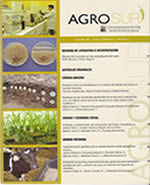ZOOMETRIC EVALUATION OF THE MATERNAL BASE IN CHILOTA SHEEP BREED COMPARED WITH TWO SHEEP BREEDS THAT ARE PREDOMINANT IN THE REGIONS OF LOS RIOS AND LOS LAGOS
Main Article Content
Abstract
The study of animal genetic resources have great importance, since they can be known native or native populations and zoometry is an instrument that contribute to this end. The objectives of this study was performs to zoometric evaluation on three sheep breeds (Chilota, Romney Marsh and Suffolk Down) and to determine whether morphostructural differences exist between them. For this we evaluated 120 ewes which 15 morphostructural measures were obtained and from these measures were developed 18 zoometric indexes. The results indicate that significant differences exist between breeds on measures of length of face and skull, skull and head width, plus the width of the hindquarters. The three breeds present eumetric characteristics. Chilota and Romney breeds have a higher morphostructural homogeneity than Suffolk. In terms of zoometrics indexes the three breeds are classified as dolichocephalic, and dolicoprosopy brachycraniota, they are also classified as brevilineous according to its body index and body proportionality. In relation to the pelvic index Chilota breed would be classified as concavilineous, and the Suffolk and Romney as convexilineous. According to the metacarpal and thoracic cage index, Chilota breed would be more prone to milk production compared to Romney Marsh and Suffolk Down breeds, which are heavier animals more related to meat production. The breeds have poor anatomical harmony, because the Pearson correlation coefficients yielded a low correlation between measures of each of the breeds. Finally, from the principal component analysis and hierarchical ascending classification Chilota breed has a clear differentiation with the other two breeds studied, both in their morphostructural measures and in their zoometrics indexes.

